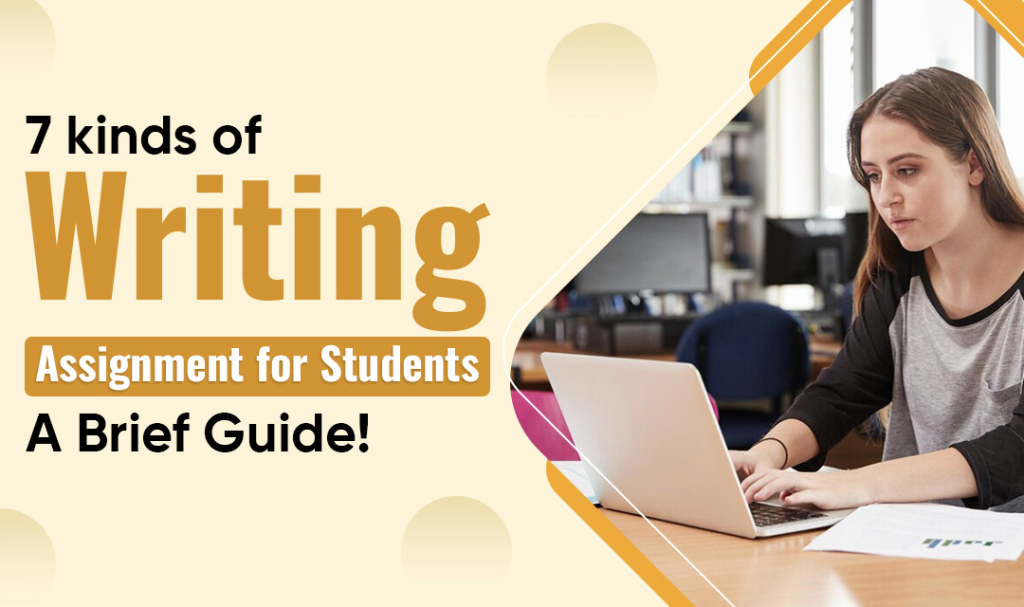
Assignments are the most popular tools for evaluating students’ knowledge and understanding of a specific topic. Therefore, students are asked to write various types of assignments during their educational journey. Each assignment type is different. Students can polish their critical thinking skills by writing these assignments and understanding their purposes.
Are you curious to know about these writing assignment types? Then this article is for you. Here, we’ll share seven types of writing assignments for high school and identify which writing style is the best for assignments.
Continue reading to explore the key insights of this article first.
Key Insights:
- During their educational career, students get various kinds of writing assignments.
- Each type of assignment has its own structure and writing requirements. The general structure includes an introduction, main body, and conclusion.
- The seven common writing assignments are case study responses, essays, analyses, reflective writing, reports, annotated bibliographies, and literature reviews.
- To get academic achievements, students need to learn how to write each assignment type by following the requirements given by the teachers.
7 Kinds of Writing Assignments for Students
Assignments and assessments are similar; professors often give assignments to students to assess their mental abilities. These assignments not only stimulate assessment but also help in achieving academic goals. According to Research Gate, 72% of experts believe that assignments significantly improve academic achievements. However, there are various kinds of writing assignments that vary by length and purpose.
Read on to learn different types of writing assignments.
- Case Studies Responses
Case studies response is one of the most common kinds of writing assignment, but most students fail to score high grades in the assignment genre.
Below are some key reasons for losing marks in this document.
- Students don’t relate their answers to the case study details.
- Their assignment structure is unclear.
- Lack of using critical thinking.
- They do not use an accurate reference format.
Students can get assistance from their teachers, tutors or professional assignment writing services. They can also follow some tips to earn good grades in case study responses. These tips are the following:
- Structure their answer according to the case study and always refer to the given case study.
- Write their case study response like the essay body, but add examples from the given case study to support their arguments.
- Analysis
Students usually get an assignment to write an analysis on any subject or topic. Below are some common analysis types.
- Causal Analysis: In this type of analysis, the writer explores the reasons why something happened or happened in the past.
- Comparison Analysis: In comparison analysis, students compare two individuals’ works and explain the significance of the similarities between their works.
- Literary Analysis: It is also known as critique, in which a writer reads someone else’s literary work and gives their interpretation.
- Rhetorical Analysis: In rhetorical analysis, students review the strategies that writers have used to achieve certain results in their work.
- Critical Analysis: In this analysis type, students give reasoning and arguments about the authors’ work.
- Process Analysis: Students have to state the steps involved in producing something while writing this analysis.
- Reflective Writing
Reflective writing is a popular assessment tool used generally at the university level. It involves exploring experiences, feelings, opinions, or events to gain a clear understanding of the assigned topic. Furthermore, this writing is not like writing a summary; it requires analysing a certain situation, event, or problem and its impact on one’s thinking.
In simple words, a reflective process involves looking back to past experiences, thinking critically about them, and drawing conclusions for future experiences. Additionally, developing reflective skills enables students to use the feedback for growth and betterment in their professional lives.
There are various reflective writing models which your teacher has predefined in the guidelines. But if the model is not specified, you can use one of them, which we are going to mention below.
- The Gibbs’ Reflective Cycle
This reflective cycle requires you to consider your feelings during the reflective writing process. This model is typically popular in health-related assignment writing.
- The 4 Rs of Reflective Thinking
The 4 R’s model is specifically designed to encourage students to get involved in experiential learning. These experiential learning and reflective practices are used in Creative Arts, Philosophy, and Sociology.
- Essay
An essay is one of the most popular kinds of writing assignments. It presents the author’s perspective on the topic with the help of evidence. Moreover, an essay assignment has the following key characteristics.
- It allows students to synthesise the ideas that they have learned in the class.
- An essay typically consists of arguments, claims, and thesis statements.
- It relies on the evidence that is usually gathered from books, articles, or other authentic resources.
- It requires a good structure, which includes an introduction, a main body, and a conclusion. Generally, an introduction and conclusion cover 10% of the word count, and the remaining word count has to be divided into body paragraphs.
- Report
A report consists of organised information about a problem which is under rigorous investigation. An individual can gather this information from readings, conducting experiments, or experience.
This assessment type is not only used in education but it is a common writing document which is used in business, healthcare, technical, and scientific occupations. In addition, a report can be written in different structures depending on the purpose and discipline.
Below are some of the most common report types that are categorised based on their purposes.
- Business Report: Convey information about business decisions.
- Summary Report: Give the key information about some event.
- Technical Report: Discuss technical problems and solutions.
- Scientific Report: Encompass the results of some experiment or laboratory work.
- Annotated Bibliography
An annotated bibliography is an alphabetical list of reliable sources on a subject matter. It also includes a summary, explanation, and evaluation of the topic. The main purpose of the assignment type is to teach students to conduct research, evaluate sources, and present them in an organised way.
To write a good bibliography, you must check the guidelines to learn how many sources are required to annotate and what the word limit is for each reference.
When you write your annotated bibliography, take into account the following factors.
- Determine your topic and any specific question that you need to answer.
- Identify the sources on which you need to focus.
- Check the credibility of the sources.
- Literature Review
Many students easily get confused between literature review and systematic literature review. Although both terms are more or less similar there is a key difference between them.
- Literature Review: This review analyses the literature related to your topic clearly and logically. This review should be organised conceptually, methodologically, and chronologically.
- Systematic Literature Review is a complex research process that requires clear research protocols to avoid reviewer bias.
Therefore, when your teacher assigns this kind of writing assignment, identify which type of literature he expects to write. Additionally, a literature review doesn’t need to summarise each source related to your topic, but it aims to identify any gap in research.
You have to analyse and synthesise the common ideas from past research and present them in a key theme which is related to your topic. As you have learned the different kinds of writing assignments, now explore which writing style is best for assignments to secure high grades.
Which Writing Style is Best for Assignment?
When students are asked to write an assignment, the first thought that comes to their mind is writing an essay assignment. They instantly think about the writing style that they can use; it is likely a discursive style. However, there are various kinds of assignments, including essays, reports, annotated bibliographies, analyses, and literature reviews. For all these types, you cannot use a discursive style.
There are three main writing styles that you can use in writing these assignments, depending on the requirements and purpose of each assignment.
These styles are the following:
- Analytical
- Descriptive
- Reflective
Conclusion
To conclude, students encounter a variety of assignment types throughout their educational journey, and understanding each type is crucial for academic success. This article has highlighted the seven most common writing assignments students often receive, along with practical tips and strategies to help tackle each one effectively.
If you need support while working on your academic papers, custom assignment writing platforms in the UK can provide valuable assistance. We hope these guidelines offer you a clearer understanding of different assignment types and help you approach each one with confidence.






